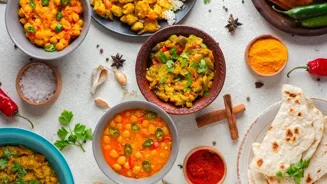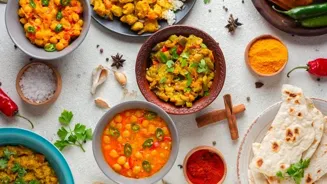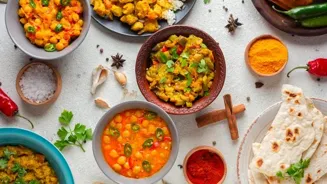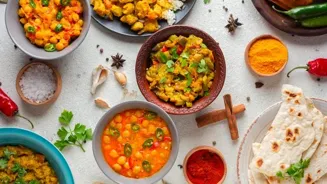Unveiling the Global Journey of Indian Curry - Explore the diverse adaptations and cultural fusion worldwide!
The aroma itself is a journey. The mention of 'curry' immediately conjures images of vibrant
spices, rich gravies, and a comforting warmth that resonates deeply with Indian palates.
But the beautiful truth is that "curry," as understood globally, is far more than just one dish; it's an umbrella term for a diverse range of preparations that have been adopted, adapted, and transformed across continents.
The journey of Indian curry around the world is a fascinating study of cultural exchange, culinary innovation, and the enduring power of simple, flavourful food.
From the bustling street food stalls of Southeast Asia to the Michelin-starred restaurants of Europe, the essence of Indian spice blends persists, woven into unique and delicious expressions of regional cuisine.
What began as a home-cooked meal has evolved into a global phenomenon, each adaptation whispering tales of spice routes, colonial legacies, and the universal love for good food.
British popularized 'curry' globally, adapting Indian flavors to Western palate
The British played a significant role in popularizing curry outside of India, initially encountering it during their colonial rule. What they termed "curry" often encompassed a simplified version of complex Indian dishes, catering to British tastes.
This 'anglicized' curry became a staple in British households and restaurants, eventually making its way to other parts of the world through the British Empire. Chicken Tikka Masala, for example, a dish often considered a British national dish, is a testament to this cultural fusion.
Despite its origins being debated, it represents an adaptation of Indian flavors to suit a Western palate. The popularity of these curries in Britain then spurred further adaptations and interpretations as they spread across the globe.
Even today, the 'Indian' food served in many Western countries owes its existence to this early British influence.
Indian curry influences in Southeast Asian cuisines: Thailand, Malaysia, Indonesia
Moving eastward, we find the flavours of Indian curries deeply embedded in Southeast Asian cuisine. Thailand, Malaysia, and Indonesia boast their own unique versions, each infused with local ingredients and techniques.
Take, for example, the Thai green curry, known for its vibrant colour and herbaceous aroma.
While it shares the concept of a spiced gravy base, Thai green curry incorporates ingredients like green chilies, galangal, lemongrass, and kaffir lime leaves, setting it apart from traditional Indian preparations.
Similarly, Malaysian curries often feature coconut milk and spices like star anise and cloves, reflecting the region's abundance of these ingredients. Indonesian rendang, a dry curry, is another testament to the diverse interpretations of Indian curry influences.
Caribbean cuisine blends Indian curry with local flavors, creating unique dishes
The Caribbean islands also display a distinct love for curry, a legacy of Indian indentured laborers brought to the region during the 19th century. Dishes like curry goat and curry chicken are popular staples, showcasing a unique blend of Indian spices and Caribbean flavors.
The use of scotch bonnet peppers adds a fiery kick, while local spices like allspice and thyme contribute to a distinct Caribbean flavor profile. These curries are typically served with rice, roti, or other local breads, reflecting the region's diverse culinary heritage.
The adaptations in the Caribbean demonstrate how Indian dishes blended with local ingredients to create delicious dishes.
Currywurst: fusion of Indian spices in German street food
Germany may appear to be an unlikely place for a vibrant curry scene, but its Currywurst stands as a testament to the global charm of Indian spices. This popular street food consists of sausage, steamed and then fried, smothered in a tomato-based sauce seasoned with curry powder.
While a far cry from traditional Indian curries, Currywurst demonstrates the adaptability and simplification of the "curry" flavour profile. It serves as an easy, affordable, and delicious meal. It highlights the extent of the impact that curry has and the way flavor profiles impact the world.
Japanese curry rice reflects Indian influence in global cuisine, showcasing cultural exchange
Even in Japan, the influence of Indian curry is felt in the form of Japanese curry rice (Karē Raisu), a mild and comforting dish typically served with rice and pickled vegetables.
Introduced during the Meiji era, this curry has been adapted to suit Japanese tastes, resulting in a thicker, sweeter sauce compared to its Indian counterparts. The flavors have been influenced by the country.
This illustrates how the fundamental spirit of curry has been reinterpreted and reinvented across cultures, each variation telling a story of cultural exchange and culinary evolution.
The impact is so high that many countries now have their own interpretation of curry as well as dishes, this goes to show that Indian dishes have a great influence world wide.
AI Generated Content. Glance/InMobi shall have no liability for the content












